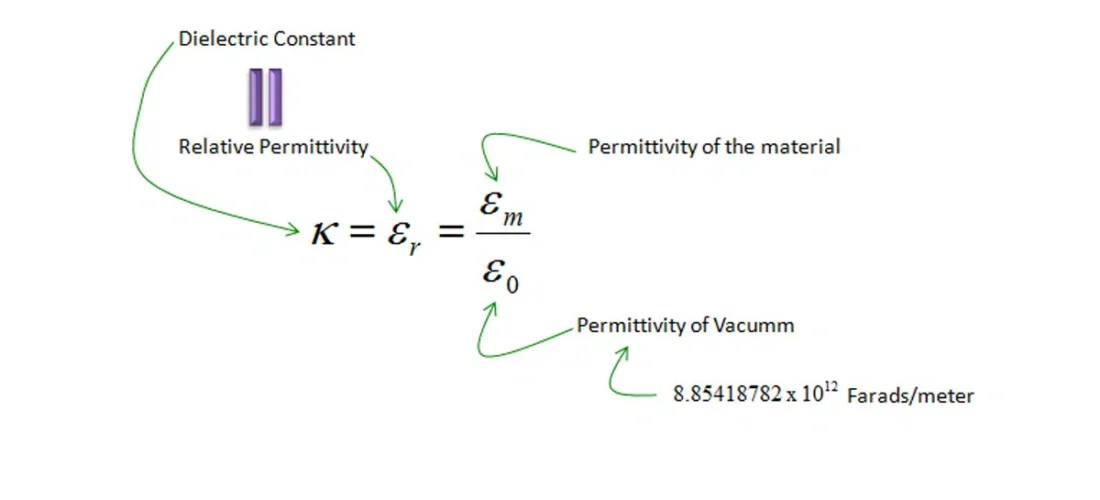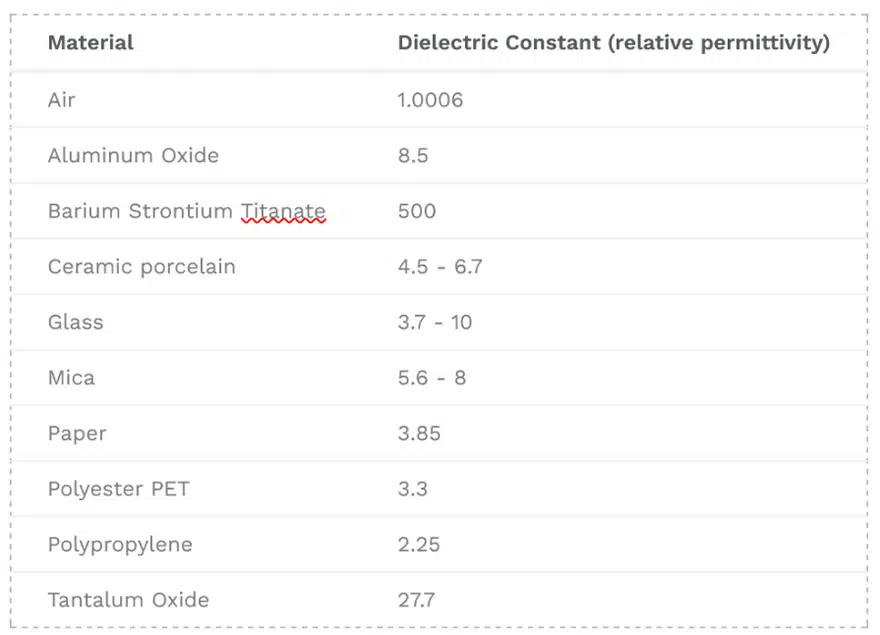
Dielectric Constant and its Effects on the Properties of a Capacitor
- Posted by doEEEt Media Group
- On September 12, 2022
- 0
A typical capacitor comprises two conductive plates and non-conductive dielectric material. The dielectric material separates the two conductive metal electrode plates. Applying voltage to the electrode plates of a capacitor causes an electric field in the non-conductive dielectric material. This electric field stores energy. The dielectric constant, also known as relative permittivity, is the measure of the ability of a material to store electrical energy and is one of the key properties of a dielectric material.
The capacitance of a parallel plate capacitor is a function of distance between plates, plate area, and dielectric material constant. An increase in plate area and dielectric constant increases capacitance, while an increase in the separation distance between the plates decreases capacitance. Different dielectric materials have different dielectric constants.
Effects of dielectric constant on the characteristics of a capacitor
The dielectric material of a capacitor polarizes when voltage is applied. This process reduces the electric field and causes negatively charged electrons to shift slightly towards the positive terminal. Although the electrons do not shift far enough to cause a flow of current, the process creates an effect critical to the capacitors’ operation. Removing the source of voltage causes the dielectric material to lose polarization. However, if the material has weak molecular bonds, it can remain in a polarized state even when the voltage source is removed.
A capacitor stores energy in the electric field when a voltage is applied. The capacity to store electrical energy varies from one dielectric material to another. The amount of electrical energy a capacitor can store is influenced by the amount of polarization that occurs when voltage is applied. Materials with high dielectric constants can store more energy than those with low dielectric constants. The electric susceptibility of a material is a measure of the ease with which it polarizes in response to an electric field. Good dielectric materials have high electric susceptibility.
The dielectric constant is one of the key parameters to consider when selecting a dielectric material for a capacitor. This constant is measured in farads per meter and determines the amount of capacitance that a capacitor can achieve. Dielectric materials with high dielectric constants are used when high capacitance values are required, although, as mentioned above, other parameters that determine the capacitance of a capacitor include the spacing between the electrodes and the effective plate area.
Dielectric constants of common dielectric materials
All materials are capable of storing electrical energy when they are exposed to an electric field. The storage capacity varies from one material to another. The permittivity of materials is usually given relative to the permittivity of free space, usually symbolized by ϵ0. The permittivity of a vacuum is commonly known as absolute permittivity and refers to the resistance required to form an electric field in a vacuum. The absolute permittivity of free space is approximately 8.85418782 × 10-12 m-3 kg-1 s4 A2.
The permittivity of a dielectric material relative to that of free space is referred to as relative permittivity, usually symbolized by ϵr, or dielectric constant. The following equation relates absolute permittivity (ϵ0), relative permittivity or dielectric constant (ϵr), and permittivity of a material (ϵ).
ϵr=ϵϵ0
The table below shows the dielectric constants of commonly used dielectric materials.

Dielectric constant (permittivity) overview table
There are many other materials with dielectric properties; an overview of dielectric constant on a wide range of organic plastic materials is provided in the article here.
Variations in temperature cause discontinuities in the permittivity of a dielectric material and significantly affect the dielectric constant of a material. For instance, an increase in temperature causes a decrease in permittivity, and the material’s dielectric constant drops sharply when the temperature falls below the freezing point.
When selecting a dielectric material for a capacitor, it is also important to consider the effect of frequency on the material’s properties. The permittivity that a material exhibits when exposed to an electric field depends on the frequency of the voltage source. When a material is placed in a static electric field, its exhibit permittivity is referred to as static permittivity. The permittivity of a material decreases with an increase in the frequency of the voltage source.
A primary drive today is towards circuit miniaturization. To produce miniature circuits, components with a smaller footprint are required. The dielectric constant of a capacitor determines the capacitance that can be achieved. Dielectric materials with high dielectric constants are used when capacitors with smaller physical sizes are required.
Apart from the dielectric constant, it is also important to consider dielectric loss and dielectric strength when selecting a dielectric material for a capacitor. The dielectric strength measures the voltage an insulator will withstand before it allows current to flow through it. Dielectric loss refers to the energy that a dielectric material dissipates when a variable voltage is applied.
Source: EPCI
- Managing EEE components for LEO and lower cost space missions - December 17, 2024
- Filtering Characteristics of Parallel-Connected Fixed Capacitors in LCC-HVDC - November 21, 2024
- ALTER SPACE TEST CENTER: testing approaches for New Space - September 30, 2024


0 comments on Dielectric Constant and its Effects on the Properties of a Capacitor